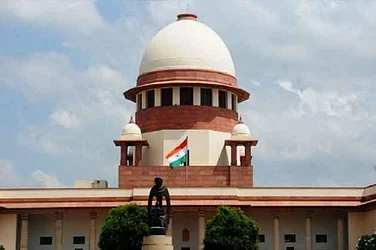Following the controversy over the Taj Mahal, the Allahabad High Court on Thursday dismissed a plea seeking a ''fact-finding inquiry'' into the history of the Taj Mahal and the "opening of 22 rooms'' on the monument's premises, saying the petitioner failed to point out which of his legal or constitutional rights were being infringed.
The Lucknow bench of justices DK Upadhyay and Subhash Vidyarthi pulled up the lawyer of petitioner Rajneesh Singh, who is the media in charge of the BJP's Ayodhya unit, for filing the PIL in a "casual" manner and said it cannot pass an order under Article 226 of the Constitution in the matter.
The article empowers a high court to issue to any person or authority in the area under its jurisdiction orders or writs to enforce the fundamental rights.
What the court said
The bench said that the petitioner could not point out as to which of his legal or constitutional rights were being infringed.
According to media reports, the court further stated, "The plea to constitute a fact-finding committee to find out the 'real truth' behind the Taj Mahal is a non-justiciable issue. The prayers cannot be adjudicated upon by this court."
"For the prayer regarding opening up of the rooms, the historical research ought to involve a proper methodology. This should be left to the historians," it further noted.
What the petition said
The writ petition was filed on Saturday in the registry of the Lucknow bench of the High Court by Rajneesh Singh seeking a fact-finding inquiry into the history of the Taj Mahal. It also sought opening of the doors of its "22 rooms" to see "the truth, whatever it is".
The petitioner's lawyer Rudra Vikram Singh urged the court to permit him to withdraw the petition and file a fresh plea, but the bench did not accept his request and dismissed the petition.
The petition also sought the setting aside of certain provisions of The Ancient and Historical Monuments and Archaeological Sites and Remains (Declaration of National Importance) Act 1951, and The Ancient Monuments and Archaeological Sites and Remains Act 1958, under which the Taj Mahal, Fatehpur Sikri, Agra Fort, Itimad-ud-Daulah's tomb were declared historical monuments.
What BJP said
Several Hindu right-wing outfits have claimed in the past that the Mughal-era mausoleum was a Lord Shiva temple. The monument is protected by the Archaeological Survey of India (ASI).
On Wednesday, BJP’s Diya Kumari claimed that a palace of the erstwhile Jaipur royal family once stood on the land where the Taj Mahal was built and that Mughal emperor Shah Jahan had “occupied” it.
She said, "Mughal emperor Shah Jahan ‘occupied it’ as it was their [Mughal] government then. If a government acquires land from you, it gives you compensation but I have heard that in this case there was no compensation given by the Mughals to Jaipur royals. As there was no law where one could appeal than."
Commenting on the petition filed in the HC, she said, "It is good that he raised the voice. I believe that there should be an inquiry and sealed parts of the Taj Mahal should be opened to find out more. Only a proper enquiry can establish facts. And if it is needed, we will submit the documents in the court."
What historians said
Slamming the politicians' facts ' half-truths', historian Rana Safvi shared copies of farmans (royal orders) from Shah Jahan to Raja Jai Singh on Twitter and wrote that four havelis were given to Jai Singh in exchange for the land for the Taj Mahal.
Sharing copies of farmans from the book Taj Mahal – The Illumined Tomb, edited by by WE Begley and ZA Desai, she wrote, "While Raja Jai Singh was willing to donate the land for free, four havelis were given in lieu of Raja Man Singh's haveli by Shah Jahan. This farman is locked up in the Kapad Dwara collection in the City Palace Museum."
In an earlier interview with Outlook, historian Ira Mukhoty, author of the book Akbar: The Great Mughal, echoed Safvi and pointed out that Mughals and Jaipur royals were close since Akbar married Harkha Bai of Amber. She further stated that such false claims about the Taj Mahal originate from a single source – a book by PN Oak, a fantasist, who claimed that many great Asian monuments, including the Kaaba in Mecca, were all results of ‘Hindu architecture’.
(with PTI inputs)


























